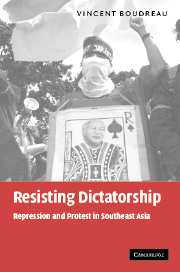Book contents
- Frontmatter
- Contents
- List of maps
- Acknowledgments
- List of abbreviations
- 1 Introduction
- 2 Protest, repression and transition in Southeast Asia
- 3 Authoritarian attack and dictatorial rise
- 4 Protest in socialist Burma
- 5 New Order repression and the Indonesian opposition
- 6 The Philippine new society and state repression
- 7 Repression and protest in comparative perspective
- 8 People power and insurgency in the Philippine transition
- 9 Protest and the underground in Burma
- 10 Indonesia's democracy protests
- 11 Democracy protest and state repression
- List of references
- Index
7 - Repression and protest in comparative perspective
Published online by Cambridge University Press: 15 December 2009
- Frontmatter
- Contents
- List of maps
- Acknowledgments
- List of abbreviations
- 1 Introduction
- 2 Protest, repression and transition in Southeast Asia
- 3 Authoritarian attack and dictatorial rise
- 4 Protest in socialist Burma
- 5 New Order repression and the Indonesian opposition
- 6 The Philippine new society and state repression
- 7 Repression and protest in comparative perspective
- 8 People power and insurgency in the Philippine transition
- 9 Protest and the underground in Burma
- 10 Indonesia's democracy protests
- 11 Democracy protest and state repression
- List of references
- Index
Summary
That contention broadly differs across the cases should by now be reasonably clear. This chapter endeavors to set forth the dimension and logic of those differences in more explicit terms. First, however, consider for a moment the significance of that variation for the study of protest. I hope in part to be demonstrating that one cannot characterize contention in these cases merely by how they differ from baseline cases in the industrial world, better represented in social movements theory: since the set does not hold together as similar examples of “third-world” or even “Southeast Asian” contention, it confounds efforts to concentrate merely on the variables that distinguish first- and third-world cases (i.e. levels of development, democracy or state capacity). Instead, the cases demonstrate the central importance of how interactions between states and societies create an institutional, political and cultural terrain that shapes subsequent contention.
To broadly restate these differences: In Burma, years of quiet were punctuated by massive protest that invariably began with widespread economic dislocation, moved to more coordinated struggle and ended with radicalized protests and state violence. During each upsurge, demonstrations grew more organized as the ferment produced new leaders, and underground activists emerged from hiding to play stronger roles. Apart from these demonstrations, ethnic and communist insurgencies consistently engaged state forces, but seldom coordinated with urban protest movements. In Indonesia, protest occurred more frequently, and with less necessarily dire consequences.
- Type
- Chapter
- Information
- Resisting DictatorshipRepression and Protest in Southeast Asia, pp. 152 - 175Publisher: Cambridge University PressPrint publication year: 2004



